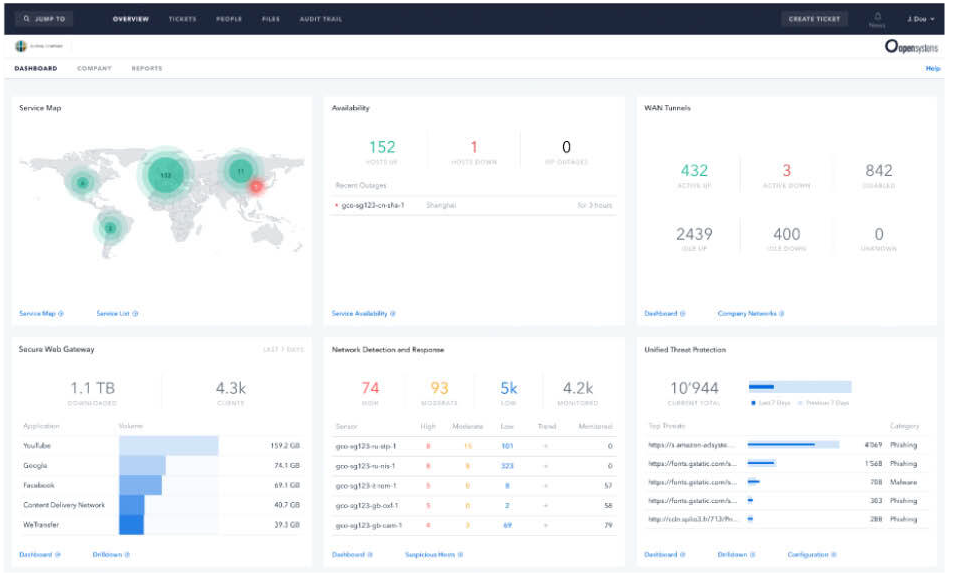
What is Network Firewall Security?
Network firewalls have been in operation since the late ’80s and have been a first line of defense in network security for over 25 years. It is their task to protect the corporate network from the Internet. Network firewall security monitors network traffic and acts as a barrier to allow non-threatening traffic in and keep threatening traffic out. A firewall can be hardware, software as a service (SaaS), public cloud, or private cloud (virtual).
The Internet is a beehive of cybersecurity threats such as malware, phishing, viruses, and ransomware. Thanks to an army of cyber criminals, modern businesses need to continually advance their cybersecurity posture to stay protected.

Types of Firewalls
- Packet Filtering: The cheapest and quickest way to analyze and distribute a small amount of data according to filters standards.
- Proxy Service: Network security systems that protect while filtering messages at the application level.
- Stateful Inspection: Dynamic packet filtering that monitors active connections to determine which network packets to allow through the Firewall.
- Next Generation Firewall (NGFW): The most advanced firewall protection that blocks modern threats such as advance malware and application layer attacks.
The Network Firewall
Connecting the network with the Internet isn’t as easy as it looks.
Basic Network Firewalls
As the name implies, firewalls provide a wall or barrier between the corporate network and an unknown and untrusted network, such as the Internet. Network firewall security controls and monitors incoming and outgoing network traffic based on established security policies. Basic network firewall security capabilities include,
- Packet screening, filtering, and blocking to protect the network from packets that do not fit with predefined rules. As an example, network firewalls use packet header information, such as the name of a particular protocol, to determine whether a packet from a certain program or application should be allowed through and into the network.
- VPNs (Virtual Private Networks) are connections that encrypt and protect remote user data to keep them, and the network secure even if users are working beyond the edge of the corporate enterprise.
Next-Generation Network Firewalls (NGFWs)
NGFWs (Next-Gen Network Firewalls) are the 3rd generation of firewalls. NGFWs include more layers of the OSI model. They include standard network firewall security capabilities and add additional features.
- TLS/SSL encrypted traffic inspection, which decrypts SSL encrypted communication data so it can be inspected. Once cleared, SSL re-encrypts the data and completes the communication.
- DPI (Deep Packet Inspection) allows the network firewall to inspect the contents of the packet. This makes it possible for the network firewall to identify and block malicious content that might include malware, ransomware, viruses, or phishing attacks.
- IPS (Intrusion Prevention System) detects and prevents known threats and sends alerts to security experts for further action.
- QoS/bandwidth management
- Integration with third-party identity management applications such as RADIUS, Active Directory, and LDAP.
Network Firewall–as-a-Service (FWaaS)
Firewalls-as-a-Service is a firewall security system delivered as a cloud-based service. With FWaaS, corporations can now move their network security processes to the cloud. Traffic from data centers, branches, remote users, and cloud applications can be centrally collected and protected using this service.
Download our eBook. This new approach to networking comprises a set of truly integrated, cloud-managed security services delivered on-prem or in the cloud with centrally managed security. Learn how to:
- Reduce complexity and operational overhead
- Deliver ease of use/transparency for users
- Enhance security with zero-trust network access

Next Generation and Cloud-Based Firewalls Muddy the Water
By definition, SWGs (Secure Web Gateways) and NGFWs (NextGen Firewalls) have a very similar purpose. They prevent suspicious traffic from entering or leaving the network. DNS (URL filtering), DLP (Data Leakage/Loss Prevention), application-level awareness, and detection of malware are some of the key features promoted by secure web gateway providers. At the same time, network firewall providers make similar claims.
Not all secure web gateways and network firewalls can perform all those services, nor should they. This is a heavy burden for a single system, especially if the organization has a high volume of internet traffic. Performance may be improved and latency reduced by spreading security services across multiple devices – network firewalls and secure web gateways. The network firewall may be performing DPI (Deep Packet Inspection) and SSL scanning while the gateway is delivering DLP (Data Loss Protection) and URL filtering.
The challenge is that an architecture with two or three separate processes, each with its own inspection, discovery, and action is likely to be more accurate but may induce latency if the processes are serial in nature.

Real-World Applications of Firewalls
In the bustling digital marketplace, e-commerce platforms are ripe targets for data breaches. Packet Filtering Firewalls serve as vigilant gatekeepers, scrutinizing tiny data packets against predefined security filters, ensuring only legitimate traffic flows through, safeguarding transactional data.
For educational institutions, embracing digital transformation while preserving academic integrity and student privacy is paramount. Here, Proxy Service Firewalls act as intermediary fortresses, meticulously filtering internet requests, thereby thwarting access to malicious or distracting websites, and maintaining a conducive digital learning environment.
In the corporate sphere, with the surge in remote work culture, the sanctity of internal communication and the security of intellectual property can’t be overstated. Stateful Inspection Firewalls remember the state of active connections, allowing seamless, secure communication for remote employees while impeding unsolicited traffic, preserving operational continuity.
Healthcare providers, entrusted with sensitive patient data, grapple with stringent compliance mandates. Next-Generation Firewalls (NGFWs) emerge as holistic guardians, with their prowess to inspect the payload of packets, ward off sophisticated malware, and provide robust application awareness, they ensure patient data remains impenetrable, compliance is met, and seamless telehealth services continue.
For burgeoning startups relying heavily on public clouds, the agility of Firewall-as-a-Service (FWaaS) is a boon. With its centralized, cloud-native architecture, FWaaS adapts to the dynamic needs of startups, providing robust security posture without the heavy investment in physical infrastructure, thereby fostering innovation and growth.
In the interconnected world we navigate, firewalls are not mere technical jargon but the sentinels of our digital dominions. They are as varied as the businesses they protect and as dynamic as the threats they combat. Understanding their real-world applications underscores their indispensability in crafting a resilient cybersecurity strategy, tailored to the unique needs of each enterprise.
Open Systems Network Firewall Security
A next-generation network firewall and secure web gateway may be able to provide the cybersecurity posture you require. For performance-sensitive and distributed networks, a more comprehensive and holistic cybersecurity stack may be more suitable.
Contact our customer advocates and learn about our single-pass cybersecurity architecture and SASE services.

Leave Complexity
Behind
To learn how Open Systems SASE Experience can benefit your organization, talk to a specialist today.
Contact Us




